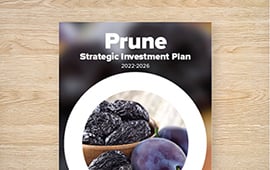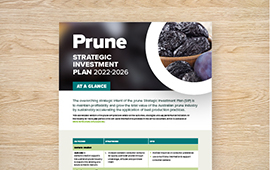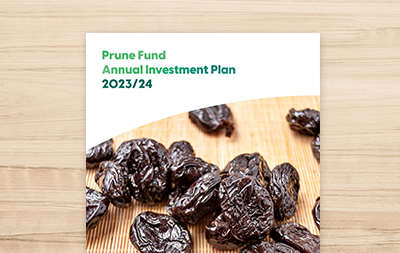What is the prune levy?
Levy is payable on prunes that are produced in Australia and either sold by the producer or used by the producer in the production of other goods. The R&D levy rate on prunes is set at $13 per tonne.
This levy is collected by the Australian Government and then entrusted to Hort Innovation. It is then Hort Innovation’s responsibility to work with industry to invest the levies – together with Australian Government funds in the case of R&D – into strategic R&D initiatives.
You can find full details on the levy rate, plus information on how to lodge a return and make a payment with the Department of Agriculture and Water Resources, on the government website here.
How are levy investment decisions made?
Investments specific to the Hort Innovation Prune Fund are guided by the industry’s Strategic Investment Plan (SIP) and Annual Investment Plan (AIP). SIPs provide an overarching roadmap for industry to follow, and AIPs detail how levy dollars will be spent each year to achieve industry goals.
To learn more about how Hort Innovation makes investment decisions, watch the video below or scroll down for more information.
What is the prune Strategic Investment Plan?
The prune SIP 2022-2026 is the roadmap that helps guide Hort Innovation’s oversight and management of the prune investment program. The SIP lays the foundation for decision-making in levy investments and represents the balanced interests of the prune industry. The most important function of the SIP is to make sure that levy investment decisions align with industry priorities.
In 2021, the prune SIP was refreshed to reflect the current needs of the prune industry. The refresh involved close consultation with growers, industry participants and the wider research community.
The prune SIP details the industry’s strategic goals centred around four outcome areas: industry supply, productivity and sustainability; demand creation; extension and capability; and business insights. Under each of those outcomes, there are industry-specific strategies and key performance indicators that provide guidance on how the prune industry will work towards achieving the outcomes.
For the previous prune SIP, a performance report has been developed to demonstrate how investments delivered in the Prune Fund from 2016/17 to 2020/21 generated impact for prune growers. The report provides an overview of key achievements delivered through each levy investment, and how they relate to the industry’s SIP outcomes and strategies.
While this performance report provides a five-year review of the prune SIP 2017-2021, going forward an annual performance report will be provided for the prune SIP 2022-2026.
View the prune SIP 2017-2021 performance report here.
What is the prune Annual Investment Plan?
While the prune SIP provides an oversight of investment over the next five years, the prune Annual Investment Plan (AIP) explains how levy funds are going to be invested over a twelve-month period.
AIPs are developed each year by Hort Innovation, informed by the SIP and then discussed with the industry consultation panels for feedback and prioritisation. Investment decisions will be guided by the industry SIP and prioritised based on potential industry impact, as well as availability of levy funds.
The AIP provides detailed information on:
- Funding availability
- How the prune industry is investing against its SIP outcomes
- Details on current investments across R&D.
The AIP is published each year and can be seen on this page here.
Where do investment ideas come from?
There are many avenues that investment ideas come through – such as growers, delivery partners, previous projects, research networks, industry bodies, regional extension plans, and extension personnel. Before any ideas are progressed, Hort Innovation will investigate whether investment aligns with the SIP and whether investment is needed in this area.
Growers are invited to submit their ideas any time at Hort Innovation’s investment idea form or by contacting a Hort Innovation employee directly. Industry participants and delivery partners can contact a Hort Innovation employee directly if they have an idea outside of the SIP consultation process.
Any submission or suggestion will be reviewed by Hort Innovation to ensure it aligns with industry needs as identified in the SIP.
How are investments prioritised?
To gain industry insights for strategic levy investments, Hort Innovation consults with growers through the prune advisory panel.
Hort Innovation develops draft investment recommendations based on investment ideas that are aligned to the prune SIP. Each recommendation includes high-level information on the aims of the project, outcomes, deliverables and budget.
The recommendations are then taken to the relevant advisory panel for feedback and prioritisation based on potential impact and available funding. Details of projects that will be progressing are then featured in the AIP.
The prune advisory panel consists of industry supply-chain stakeholders, most of whom are levy-paying growers. Panels also include industry representative body representation and, where applicable, a lead agency representative from within the National Horticulture Research Network.
The advisory panel is in place to discuss investment ideas, in order to provide advice to Hort Innovation on potential levy investments. The advice they give is guided by the industry's SIP.
The panel provides a vital link between meeting the priorities of industry and helping Hort Innovation to make decisions on how, where and when investments need to be made.
How are investments progressed?
After the investment has been prioritised, it’s then up to Hort Innovation to get the project up and running. This involves a tender process where the best delivery partner is chosen to undertake the project. Each delivery partner needs to submit regular milestones that report on their progress and at the end of each investment, a final report is produced that is made available to industry on what the project has achieved.
How to keep track of investments
Investments in the Hort Innovation Prune Fund are detailed in the Your investments page of this Prune Fund section of Hort Innovation’s website. Resources that are produced by the projects – such as fact sheets and guides – are also available through the Research reports and more page.
Hort Innovation also sends alerts about project updates to its members. Paying a levy doesn’t automatically make you a Hort Innovation member, but signing up is free here.
The levy-funded communications program, run through the investment Prune industry communications and extension program (DP19000), also provides regular information on levy-funded activity.
Advisory panel details
Name |
Organisation |
Location |
|
Peter Calabria |
Yenda Producers Co-operative |
NSW |
|
Thomas Cheung |
Dried Fruits Australia |
VIC |
|
Phil Chidgzey |
Australian Prune Industry Association |
VIC |
|
Peter Cremasco |
PA and E Cremasco |
NSW |
|
Grant Delves |
A and G Delves |
NSW |
| Michael Zalunardro | AusPrunes | NSW |
|
David Swain |
Sunbeam Foods |
VIC |
|
|




